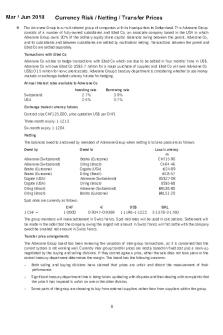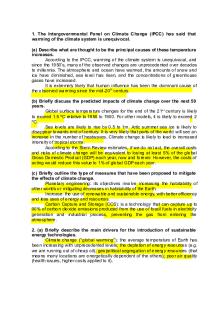Exam 2016, Answers - Past Exams Long Questions Solutions PDF

| Title | Exam 2016, Answers - Past Exams Long Questions Solutions |
|---|---|
| Course | LH Renewable Energy |
| Institution | University of Birmingham |
| Pages | 9 |
| File Size | 575.4 KB |
| File Type | |
| Total Downloads | 344 |
| Total Views | 656 |
Summary
The Intergovernmental Panel on Climate Change (IPCC) has said that warming of the climate system is unequivocal. (a) Describe what are thought to be the principal causes of these temperature increases. According to the IPCC, warming of the climate system is unequivocal, and since the 1950’s, many of...
Description
1. The Intergovernmental Panel on Climate Change (IPCC) has said that warming of the climate system is unequivocal. (a) Describe what are thought to be the principal causes of these temperature increases. According to the IPCC, warming of the climate system is unequivocal, and since the 1950’s, many of the observed changes are unprecedented over decades to millennia. The atmosphere and ocean have warmed, the amounts of snow and ice have diminished, sea level has risen, and the concentrations of greenhouse gases have increased. It is extremely likely that human influence has been the dominant cause of the observed warming since the mid-20 th century. (b) Briefly discuss the predicted impacts of climate change over the next 50 years. Global surface temperature changes for the end of the 21 st century is likely to exceed 1.5 ºC relative to 1850 to 1900. For other models, it is likely to exceed 2 ºC. Sea levels are likely to rise by 0.5 to 1m. Artic summer sea ice is likely to disappear towards end of century. It is very likely that parts of the world will see an increase in the number of heatwaves. Climate change is likely to lead to increased intensity of tropical storms. According to the Stern Review estimates, if we do not act, the overall costs and risks of climate change will be equivalent to losing at least 5% of the global Gross Domestic Product (GDP) each year, now and forever. However, the costs of acting would reduce this value to 1% of global GDP each year. (c) Briefly outline the type of measures that have been proposed to mitigate the effects of climate change. Planetary engineering: its objectives involve increasing the habitability of other worlds or mitigating decreases in habitability of the Earth. Increase: the use of renewable and sustainable energy, with better efficiency and less uses of energy and resources. Carbon Capture and Storage (CCS): is a technology that can capture up to 90% of carbon dioxide emissions produced from the use of fossil fuels in electricity generation and industrial process, preventing the gas from entering the atmosphere. 2. (a) Briefly describe the main drivers for the introduction of sustainable energy technologies. Climate change (‘’global warming’’): the average temperature of Earth has been increasing with unprecedented levels; the depletion of energy resources (e.g. we are running out of cheap oil); geopolitical segregation of energy resources (that means many locations are energetically dependent of the others); poor air quality (health issues, higher costs applied to it).
(b) (i) One method of helping to reduce energy demand is to design products that use resources more efficiently. Draw a schematic diagram to illustrate the “Cyclic Hierarchy” model.
(ii) Briefly discuss the aim of this model. The aim of this model is to slow the flow of materials and resources through society, maximising their value to society and economic opportunities throughout the life of materials. 3. (a) Describe TWO types of power plants that are commonly used to generate electricity from natural geothermal energy systems. Dry steam power plant: the steam (without water) goes directly into the turbine. Binary power plant: heat from geothermal water is used to vaporize a working fluid. The vapour power the turbine generators. (b) List the most common applications for which geothermal energycan be used directly (i.e. as opposed to ‘indirect’ electricity generation). Geothermal heat pumps, space heating, greenhouse heating, aquaculture pond heating, agricultural drying, bathing and swimming. (c) Describe the research underway to allow the use of geothermal energy in many more locations than before, e.g. in central Europe and western parts of the USA. Useful minerals, such as zinc and silica, can be extracted from the underground water; geothermal energy can create jobs and reduce reliance on oil
producing countries (security of supply), Iceland Volcanoes could generate electricity to power British homes for a decade (Daily Telegraph, 2012), Japan has the large geothermal resource and the government has been investing on it, in developing countries, geothermal can play a significant role (e.g. Philippines 21% of electricity). (d) Describe the principles underlying research into “Enhanced Geothermal Energy” or “Hot Rock” geothermal energy. Cold water is circulated down the injection well, through the reservoir and then returns to the surface through the production well as steam or hot water. Problems related: possible to cause an earthquake. 4. (a) “Life cycle assessment (LCA)” is a ‘tool’ used to assess the environmental impact of a product. What are the phases in thelife cycle of a product that are included in LCA? LCA measure and evaluate all the consumptions and emissions of a product throughout its life cycle from manufacture through use to disposal. It is ‘’from cradle to grave’’. (b) Briefly discuss the four-stage methodology generally employed when carrying out a LCA. Goal definition and scoping: identify the LCA's purpose and the expected products, determine the boundaries and assumptions based upon the goal definition; Life cycle inventory: quantifying the energy and raw material inputs and environmental releases associated with each stage of production; Impact analysis: assessing the impacts on human health and environment; Improvement analysis: evaluating opportunities to reduce energy, material inputs or environmental impacts. (c) Suggest two other ‘tools’ that can be used to assess the sustainability of a product. The energy efficiency and the ease of disassembly. 5. (a) Discuss how permanent magnets can be used in wind-powered generators. Where are such wind turbines usually located, and what type of magnets are typically used? They work by matching the power and speed of the generator to the wind system, then the power system becomes more efficient. Wind turbines use both soft and hard magnets. The choice of the material depends upon the design of the turbine, which is influenced by its location. The turbines are usually located where the speed of the wind is high and at least constant. NdFeB magnets are the most used materials. (b) What are the advantages and disadvantages of using a permanent magnet wind turbine generator, instead of an induction generator?
Advantages: no gearbox (less mass, less maintenance), no windings on rotor (no brushes, less maintenance; greater efficiency; less mass; no additional power supply, higher power to weight ratio). Disadvantages: corrosion of NdFeB magnets, technology not as well known, manufacturing of permanent magnets is not cheap, magnets are expensive. 7. (a) Draw a typical Hubbert curve for a resource such as oil, and explain some of the factors that influence the shape of the curve.
Hubbert assumed that after fossil fuels reserves are discovered, production at first increases approximately exponentially, as more facilities are installed. At some point a peak output is reached, and production begins declining until an exponential decline. The peak of the production, represented by the bell-shaped curve, does not mean that we are running out of oil, but we are running out of cheap oil. That means the technologies need to be improved even more because it has been more difficult to get access to the conventional reserves. The idea of peal oil has been around for decades, with academics arguing about if the peak has already passed or it is yet to come. (b) A huge amount of “unconventional” oil is stored in “oil sands” (or“tar sands”) in Canada and Russia. Describe the issues associated with the extraction of this oil. The unique feature of unconventional fossil fuels is its geological location: it is found in highly compact reservoirs, source rock and coal seams. The main technology that has been used is hydraulic cracking and horizontal drilling. The methane hydrates production, for example, include thermal stimulation and depressurization. It has raised concerns over possibility of catastrophic slope failure and marine ecosystem damage. (c) Describe the different approaches that are being investigated to capture carbon dioxide, and store it away from the atmosphere In an Integrated Gasification Combined Cycle (IGCC) plant, coal is fed into a
pressurised reactor, which produces syngas, hydrogen, carbon dioxide, and pollutants with sulphur. The syngas is scrubbed several times to remove the pollutants and then the hot exhausted gases are used to generated super heat streams to generate electricity in turbines. (d) List the advantages and disadvantages associated with investing in IGCC. The overall thermal efficiency of the IGCC power plant is considerably higher than the conventional coal fired power plants. A part of the CO2 as output of the gasifier can be easily captured. The biggest advantage of the IGCC is its capability to use a wide range of coals and other fuels. Current cost of IGCC is higher than the Ultra supercritical pulverised coal fired plants without CO2 capture. More components, more heat exchangers increase maintenance costs and outage times. Cleaning of the Syngas from the gasifier removes most of the emissions like sulphur dioxide. In addition, dilution by using Nitrogen in the gas turbine combustor reduces the formation of NOx. 8. (a) (i) Explain why hydrogen is widely being promoted as an alternative energy-carrier. Depletion of energy resources (especially fossil fuels), climate change, health issues caused by the air pollution, society running out of cheap oil, need to increase the use of sustainable energy and renewable processes. (ii) Identify and discuss the key challenges facing the introduction of a “Hydrogen Energy Economy”. Cost of production and delivery? Total production capacity? Can cheap, reliable fuel cells be produced? Can hydrogen be stored safety for mobile applications? Storage: problems with the height. (b) Describe the THREE principal techniques by which hydrogen can be stored on a hydrogen-powered vehicle. Discuss the main advantages and disadvantages of each technique. Under pressure. Advantages: well established technology, particularly on a relatively small scale. Disadvantages: low to moderate compression, delivers hydrogen at high pressure (safety?). Solid-state. Advantages: the volume of compressed hydrogen tanks could be greatly reduced using hydride powers. Disadvantage: too heavy for cars. Cryogenic storage. Advantages: good compression, low pressure. Disadvantages: energy losses, large energy cost of liquefaction, boil off. (c) Briefly discuss the different options available for distributing hydrogen to a national network of passenger car filling stations. Hydrogen is conventionally distributed in: gaseous form cylinders or large
pressure vessels, liquefied by tanker, liquefied by pipeline. The large scale hydrogen pipeline distribution is feasible but is likely to be very expensive. 9. (a) List the advantages and disadvantages of using photovoltaic (PV) solar cells relative to forms of energy generation utilising fossil fuels. Advantages: sustainable (no CO 2 emission), long life, very low maintenance, noise and pollution free, high level of public acceptance, only renewable energy suitable for the urban environment. Disadvantages: cannot operate without light, high initial costs overshadow the low maintenance costs and lack of fuel costs, large are needed for large scale applications. (b) Three common types of PV solar cells are: Crystalline-Si, Cd-Te and CIGS. (i) Describe how these different types of PV solar cell material are produced. They are made using cells sliced from a single cylindrical crystal of silicon. (ii) Define “Energy Payback Time” (EPT), and explain the difference in EPT value for these different type of PV solar cells. EPBT = Einput/Esaved, where Einput is the energy input during the module life cycle (manufacturing, installation, energy use during operation, and energy needed for decommissioning) and Esaved the annual energy savings due to electricity generated by the PV module. For PV power systems the EPBT depends on a number of factors: cell technology, type of encapsulation, efficiency, PV system application type and, finally, PV system performance as determined by irradiation and the performance ratio. 10) (a) Briefly describe what is meant by “Sustainable Development”. From Brundtland Report (1987) definition, it is the development that meets the needs of the present without compromising the ability of future generations to meet their own needs. According to the UK Government definition, it is the simple idea of ensuring a better quality of life for everyone, now and for generations to come. It means meeting the four objectives at the same time, in the UK and the world as a whole. The objectives are: social progress which recognises the needs of everyone, prudent use of natural resources, effective protection of the environment, maintenance of the high and stable levels of economic growth and employment. (b) Draw a typical McKelvey Diagram and use it to show the difference between reserves and resources. The diagram is a useful visualisation for classifying resources by their degrees of geologic assurance and economic recoverability.
Reserve: material can be legally and economically extracted at the moment. Resources: economic extraction is unfeasible at the moment. 11) (a) What are the advantages and disadvantages of off-shore wind farms compared to on-shore. Advantages of 1) No Noise Pollution 2) No Injuries to Birds 3) No loss in scenery
Offshore
Wind
over
Onshore
Wind
Disadvantages of Offshore Wind over Onshore Wind Cost (b) Describe the types of material that are being used, or that are being considered for use, for the rotor blades on modern wind turbines. NdFeB, Dy: have rare Earth deposits. In case of NdFeB, the ideal microstructure would have smooth grain boundaries, low porosity, perfect alignment of all grains in the same direction. Can be protected from corrosion using a nickel plated layer or using stainless steel to
encapsulate the magnet. (c) Discuss the potential for generation of renewable energy in an urban environment. Must be taken into account: Visual impact: turbines are very big and high. It requires a large area. Noisy: The noise levels get progressively less as the distance from the wind farm increases.
12)
13)
14)
15)...
Similar Free PDFs

Family Law past exams answers
- 22 Pages

MATH1081 Past exams (with answers ).
- 75 Pages

Questions bank from past exams
- 152 Pages

194.241 Past Exam 2016
- 20 Pages

Exam 2016, questions and answers
- 1 Pages

Exam 2016, questions and answers
- 5 Pages

Exam 2016, questions and answers
- 10 Pages

Exam 2016, questions and answers
- 3 Pages

Past exams AFM Questions ACCA
- 16 Pages

Exam 2016, questions and answers
- 51 Pages

Exam 2016, questions and answers
- 15 Pages

Exam 2016, questions and answers
- 15 Pages

Exam 2016, questions and answers
- 8 Pages

Exam 2016, questions and answers
- 15 Pages

Exam 2016, questions and answers
- 14 Pages
Popular Institutions
- Tinajero National High School - Annex
- Politeknik Caltex Riau
- Yokohama City University
- SGT University
- University of Al-Qadisiyah
- Divine Word College of Vigan
- Techniek College Rotterdam
- Universidade de Santiago
- Universiti Teknologi MARA Cawangan Johor Kampus Pasir Gudang
- Poltekkes Kemenkes Yogyakarta
- Baguio City National High School
- Colegio san marcos
- preparatoria uno
- Centro de Bachillerato Tecnológico Industrial y de Servicios No. 107
- Dalian Maritime University
- Quang Trung Secondary School
- Colegio Tecnológico en Informática
- Corporación Regional de Educación Superior
- Grupo CEDVA
- Dar Al Uloom University
- Centro de Estudios Preuniversitarios de la Universidad Nacional de Ingeniería
- 上智大学
- Aakash International School, Nuna Majara
- San Felipe Neri Catholic School
- Kang Chiao International School - New Taipei City
- Misamis Occidental National High School
- Institución Educativa Escuela Normal Juan Ladrilleros
- Kolehiyo ng Pantukan
- Batanes State College
- Instituto Continental
- Sekolah Menengah Kejuruan Kesehatan Kaltara (Tarakan)
- Colegio de La Inmaculada Concepcion - Cebu
